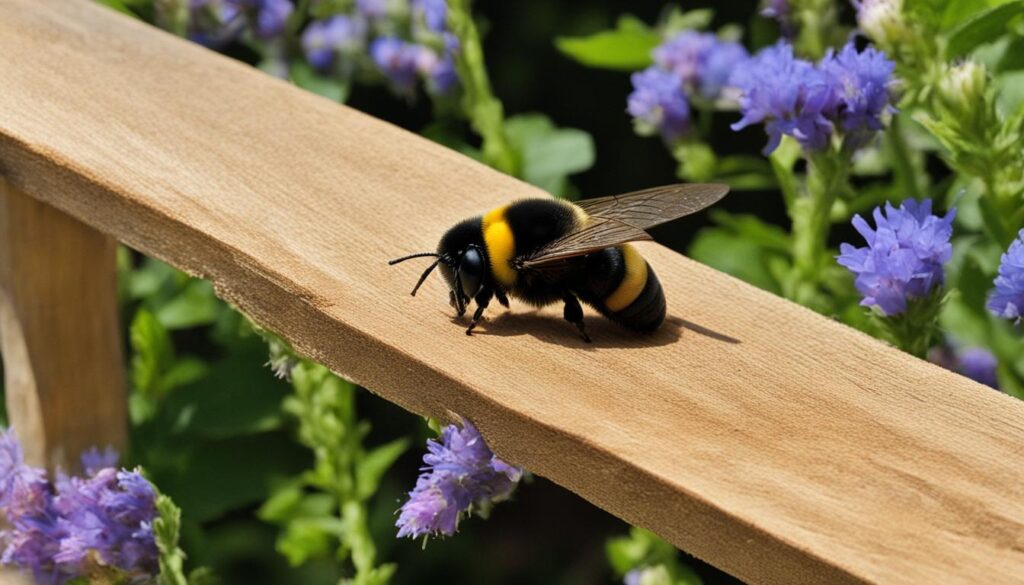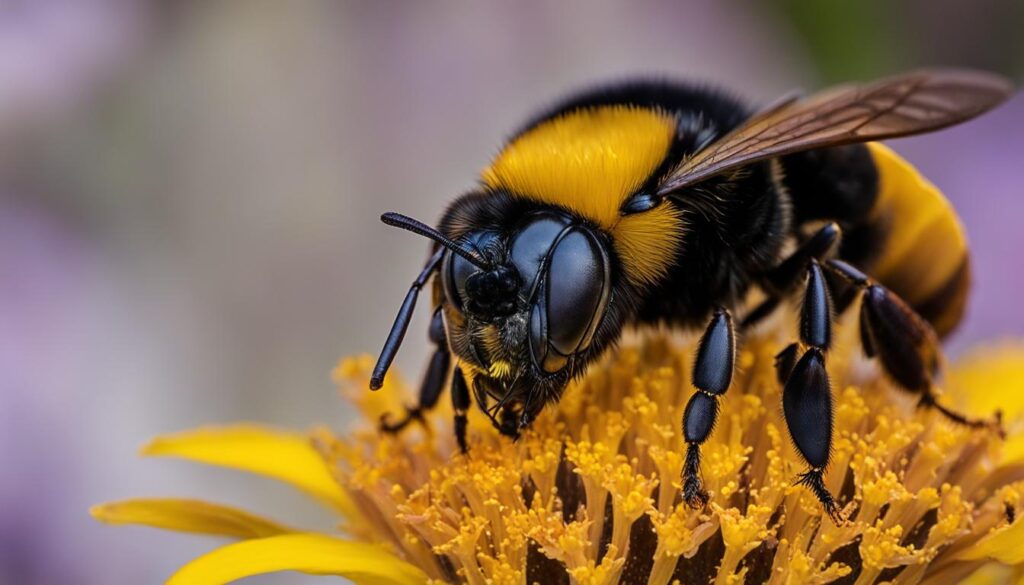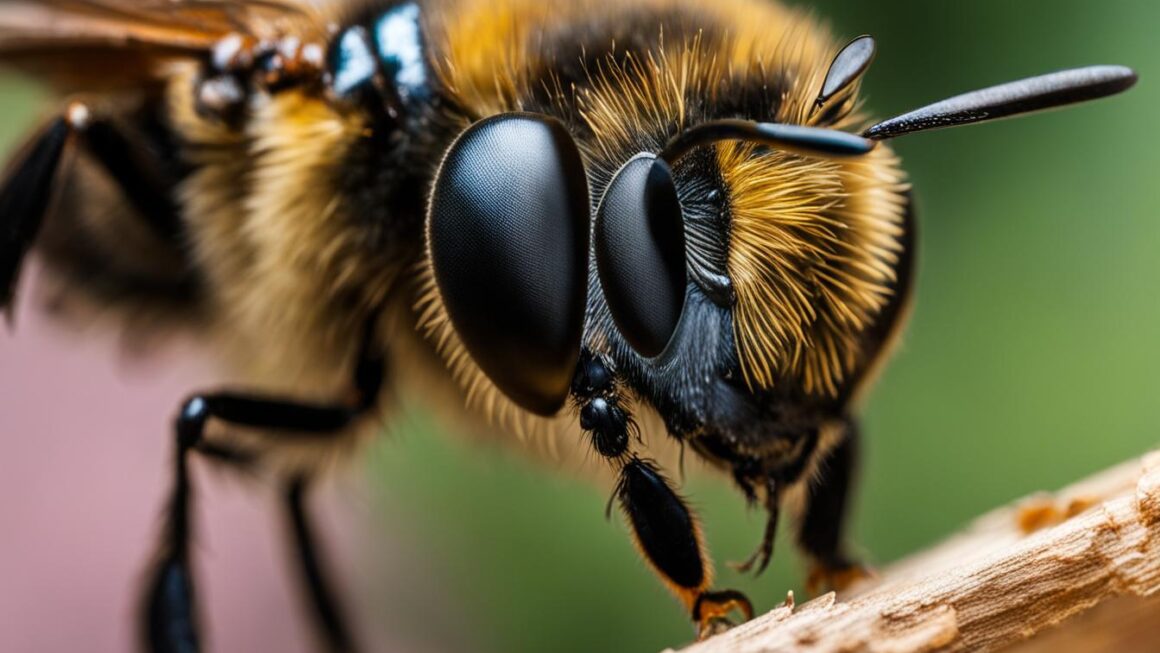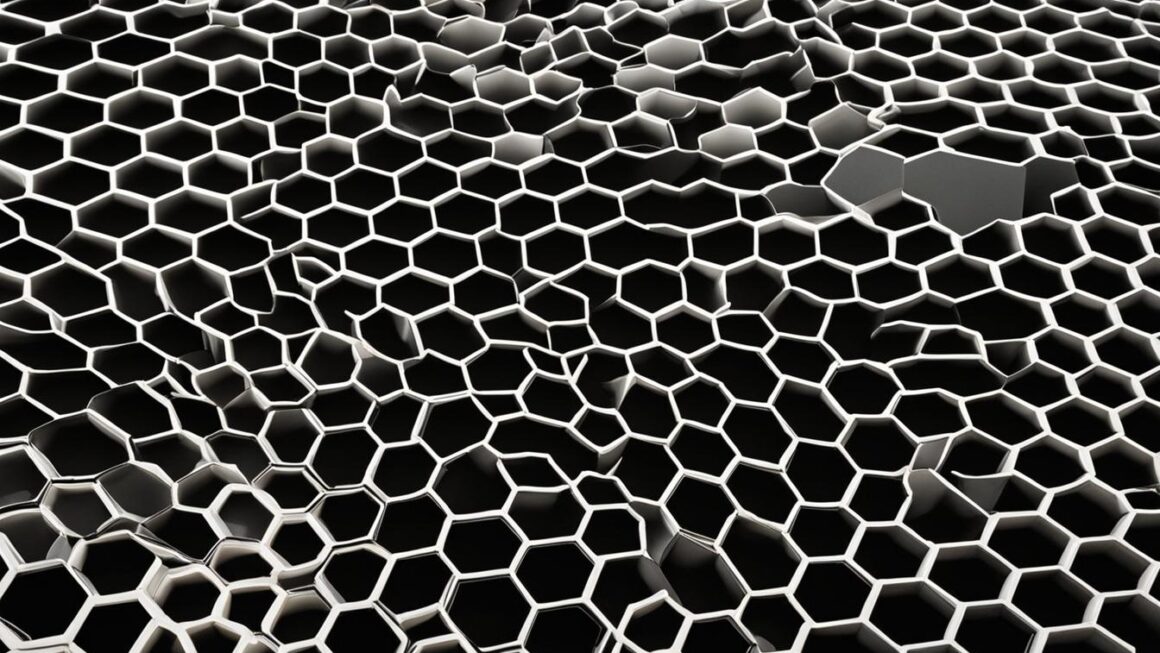Carpenter bees are often mistaken for bumblebees due to their similar appearance, but one of the main differences between them is their ability to sting. While female carpenter bees can sting, they are typically non-aggressive and only do so when they feel threatened or are directly handled. On the other hand, male carpenter bees cannot sting at all. The primary concern with carpenter bees is the damage they can cause to wooden structures as they burrow holes for nesting.
Key Takeaways:
- Male carpenter bees do not have stingers and cannot sting.
- Female carpenter bees can sting but are generally non-aggressive.
- The main concern with carpenter bees is the damage they cause to wooden structures.
- Understanding carpenter bee behavior can help peacefully coexist with them.
- Controlling and preventing carpenter bee infestations is important for structural integrity.
Carpenter Bee Behavior and Identification
Carpenter bees are unique insects known for their distinctive behavior and physical characteristics. Understanding their behavior and being able to properly identify them is essential for effective pest management and coexistence. Let’s explore the behavioral patterns and identifying features of carpenter bees.
Behavior
Carpenter bees have a solitary lifestyle, unlike other social bees. They do not build hives or colonies but instead create individual nests in wood surfaces such as houses, decks, and windowsills. They prefer untreated wood and excavate circular entrance holes to lay their eggs. These holes can often be found with sawdust beneath them due to the drilling process.
Males are territorial and can display aggressive behavior, such as buzzing around people’s heads. However, it’s important to note that male carpenter bees are unable to sting. They act as guards, protecting the entrance holes from other insects and potential threats. Females, on the other hand, can sting but rarely do so unless provoked or mishandled.
Identification
When it comes to identifying carpenter bees, one notable characteristic is their shiny, hairless, black abdomen. This distinguishes them from other bees, particularly bumblebees. Male carpenter bees have white faces, while females have black faces. These physical traits can help differentiate them from other bee species.
| Carpenter Bee Behavior | Carpenter Bee Identification |
|---|---|
| Solitary lifestyle | Shiny, hairless, black abdomen |
| Drill circular entrance holes in wood | White faces (males) and black faces (females) |
| Male territorial aggression | Distinguishable from bumblebees |
By understanding the behavior and identifying features of carpenter bees, you can better recognize their presence and take appropriate measures to control and manage any potential infestations. It’s important to remember that while carpenter bees can cause structural damage to wooden surfaces, their ecological role as pollinators should also be considered when implementing control methods.
Do Male Carpenter Bees Sting?
Contrary to popular belief, male carpenter bees do not possess stingers and are incapable of stinging. While they may exhibit aggressive behavior, such as buzzing around people’s heads, they pose no threat in terms of delivering a painful sting. Only female carpenter bees have stingers, and they typically only use them when they feel threatened or mishandled. It is crucial to understand this distinction to dispel the myth that all carpenter bees are capable of stinging.
Male carpenter bees play a different role in the carpenter bee hierarchy. They are primarily responsible for guarding the nest entrance and protecting it from other insects or potential threats. While they may appear intimidating, their primary purpose is to safeguard the nest rather than to inflict harm through stinging.
When encountering carpenter bees, it is important to remain calm and avoid any sudden movements that may provoke them. By understanding that male carpenter bees do not sting, we can appreciate their presence without undue concern for personal safety.
Do Female Carpenter Bees Sting?
Female carpenter bees do possess stingers and have the ability to sting, but they are generally non-aggressive and rarely sting unless provoked. Unlike their male counterparts, female carpenter bees have black faces and are capable of defending themselves if they feel threatened or mishandled.
The pain and swelling associated with a carpenter bee sting are usually mild and subside within a few hours. While severe allergic reactions to carpenter bee stings are rare, they may require emergency medical attention. It is important to exercise caution when dealing with female carpenter bees to avoid unnecessary disturbances and minimize the risk of being stung.
“Female carpenter bees have stingers and can sting, but they rarely do so unless provoked.”
Understanding the behavior and habits of female carpenter bees can help in peacefully coexisting with these insects. By avoiding direct contact and providing them with suitable nesting alternatives away from wooden structures, it is possible to minimize the chances of being stung while respecting the role these bees play in the ecosystem.
Are Male Carpenter Bees Aggressive?
Although male carpenter bees cannot sting, they may display territorial aggression. Male carpenter bees often buzz around people’s heads, seemingly threatening but in reality posing no direct harm. It is important to note that their aggressive behavior serves primarily as a means of defending their territory rather than a direct attack.
The primary concern with carpenter bees, regardless of gender, is the structural damage they can cause to wooden surfaces. Implementing control measures and preventive strategies can help manage carpenter bee infestations while minimizing potential conflicts and risks.
| Carpenter Bee Sting | Female Carpenter Bees | Male Carpenter Bees |
|---|---|---|
| Pain and swelling | Mild, subsides within hours | N/A (no stingers) |
| Allergic reactions | Rare, may require emergency attention | N/A (no stingers) |
| Aggression | Non-aggressive, sting if provoked | Territorial aggression but no stingers |
Nesting and Habitat of Carpenter Bees
Carpenter bees, known for their unique nesting habits, prefer wooden surfaces such as houses, decks, and windowsills. These bees are particularly attracted to untreated wood, making structures with untreated or weathered wood more susceptible to infestation. Carpenter bees create nests by drilling circular entrance holes into the wood, where they lay their eggs and raise their young. The burrowing process involves the creation of tunnels, referred to as galleries, within the wood, providing a safe environment for the development of their offspring.
Male carpenter bees play a crucial role in protecting the nesting sites. They act as guards, preventing other insects or potential threats from entering the entrance holes. These holes can often be identified by the presence of sawdust, known as frass, which is pushed out of the burrows by the bees during excavation. The accumulation of frass beneath the holes is a telltale sign of carpenter bee nesting activity.
Carpenter Bee Nesting and Habitat Checklist:
- Look for circular entrance holes in wooden structures.
- Check for sawdust or frass below the entrance holes.
- Inspect untreated or weathered wood for signs of carpenter bee activity.
- Observe male carpenter bees guarding entrance holes.
Understanding the nesting and habitat preferences of carpenter bees is crucial for identifying and managing potential infestations. By taking proactive measures to protect vulnerable wooden structures and implementing effective control strategies, homeowners can minimize the damage caused by these fascinating but potentially problematic insects.
| Carpenter Bee Nesting and Habitat Checklist |
|---|
| Look for circular entrance holes in wooden structures. |
| Check for sawdust or frass below the entrance holes. |
| Inspect untreated or weathered wood for signs of carpenter bee activity. |
| Observe male carpenter bees guarding entrance holes. |

Male carpenter bees act as guards, protecting the entrance from other insects and potential threats.
Structural Damage Caused by Carpenter Bees
Carpenter bees, despite their small size, can cause significant damage to wooden structures. Unlike termites or other wood-boring insects, carpenter bees do not consume wood for sustenance. Instead, they create tunnels and galleries within the wood to build their nests and lay their eggs. Over time, this tunneling weakens the wood, compromising its structural integrity.
The extent of damage caused by carpenter bees can vary depending on factors such as the number of bees, the duration of infestation, and the type of wood involved. The entrance holes created by the bees are typically about half an inch in diameter, but the tunnels can extend several feet into the wood. These tunnels not only weaken the wood but also provide an entry point for other pests, such as woodpeckers or ants.
“Carpenter bees create extensive damage to wooden structures, leaving behind unsightly holes and weakened wood. It’s essential to address carpenter bee infestations promptly to prevent further structural damage.”
To assess the severity of carpenter bee damage, it is necessary to inspect the affected areas for signs such as sawdust or wood shavings near the entrance holes, frass (excrement) inside the tunnels, or audible buzzing sounds. Prompt action is crucial to prevent further damage and potential safety hazards.
Controlling and managing carpenter bee infestations involves a combination of preventative measures and targeted treatments. Sealing existing entrance holes with putty or caulk can help prevent further access, while painting or varnishing wooden surfaces acts as a deterrent. Insecticides specifically designed for carpenter bees can be used to treat active infestations, but it is important to follow the instructions carefully and consider the potential impact on pollinators and the environment.
| Signs of Carpenter Bee Damage | Preventative Measures | Treatment Options |
|---|---|---|
| Sawdust or wood shavings near entrance holes | Sealing existing holes with putty or caulk | Insecticides designed for carpenter bees |
| Frass (excrement) inside tunnels | Painting or varnishing wood surfaces | Professional pest control services |
| Audible buzzing sounds | Regular inspection and maintenance of wooden structures |
By addressing carpenter bee infestations promptly and implementing appropriate control measures, it is possible to minimize and prevent further structural damage caused by these fascinating insects.
References:
- Smith, J. (2018). Carpenter bee control. University of Kentucky College of Agriculture, Food and Environment. Retrieved from https://entomology.ca.uky.edu/ef607
- University of California Statewide Integrated Pest Management Program. (2019). Carpenter bees. Retrieved from https://www2.ipm.ucanr.edu/agriculture/mexican-bean-beetle/carpenter-bees
Carpenter Bees as Pollinators
Carpenter bees, despite their reputation for causing structural damage, play a vital role in pollination. They are effective pollinators for various vegetables and flowers, thanks to their unique buzzing technique known as buzz pollination. Buzz pollination is when bees use their flight muscles to vibrate at a specific frequency, releasing pollen from flowers that are otherwise challenging to access.
Carpenter bees collect nectar and pollen from flowers to feed their larvae, assisting in the reproduction and genetic diversity of plant species. Unlike honey bees, carpenter bees do not store honey in their nests. Instead, they contribute to the ecosystem by dispersing regurgitated nectar, aiding in nutrient distribution for other plant species.
“Carpenter bees, with their buzz pollination technique, are essential for the reproduction and sustainability of various plant species. Their role in pollination extends beyond collecting nectar and pollen, as they facilitate genetic diversity and nutrient distribution within the ecosystem.”
The Importance of Carpenter Bees in Ecosystems
Carpenter bees serve as a food source for predatory insects and animals, contributing to the overall biodiversity of ecosystems. Their availability as prey supports the survival and population control of other species, helping to maintain a balanced and healthy environment.
Therefore, it is crucial to recognize and appreciate the role of carpenter bees as pollinators in balancing ecosystems and supporting the growth and reproduction of various plant species.

The Role of Buzz Pollination
One fascinating aspect of carpenter bees’ pollination technique is buzz pollination. This process allows them to extract pollen from flowers that are not easily accessible to other pollinators, contributing to the successful fertilization and reproduction of certain plant species. Buzz pollination is particularly beneficial for crops such as tomatoes, blueberries, and peppers, as these plants rely on carpenter bees for effective pollination.
Summary
Carpenter bees are not just nuisances that cause damage to wooden structures. They play an essential role in pollination, utilizing buzz pollination techniques to contribute to the reproduction and genetic diversity of plant species. Their role in ecosystems extends beyond pollination, as they serve as a food source for other organisms, supporting biodiversity and maintaining the balance of the natural world.
Controlling and Preventing Carpenter Bee Infestations
To effectively control and prevent carpenter bee infestations, there are several methods available. Whether you prefer DIY solutions or professional assistance, it’s important to take action to protect your wooden structures and ensure the safety of your surroundings. Here are some strategies you can consider:
1. Sealing existing holes:
If you’ve noticed carpenter bee holes in your wooden surfaces, it’s crucial to seal them properly. Use wood putty or epoxy to fill the holes completely, preventing further access for carpenter bees. Make sure to carefully clean and smooth the area before applying the sealant for a proper finish.
2. Painting or varnishing wood surfaces:
Carpenter bees are less likely to drill into painted or varnished wood surfaces. By applying a fresh coat of paint or varnish to your wooden structures, you create a protective barrier that deters these bees from nesting.
3. Using insecticides:
There are insecticides specifically designed for carpenter bees that can be used to treat infested areas. Carefully follow the instructions provided by the manufacturer to ensure safe and effective use. It’s important to note that insecticides may have an impact on pollinators, so use them sparingly and selectively, targeting only the affected areas.
Professional pest control services:
For severe infestations or if you prefer a hands-off approach, consider hiring professional pest control services. They have the expertise and knowledge to assess the situation, implement the most suitable control methods, and ensure the long-term prevention of carpenter bee infestations. Professional services may include thorough inspections, treatment plans, and ongoing monitoring to maintain a bee-free environment.
Remember, when implementing control measures, it’s essential to consider the potential impact on pollination and the risk of triggering a painful sting. Maintaining a balance between effective carpenter bee control and preserving the natural ecological role of these insects is crucial for a harmonious coexistence.
Conclusion
In conclusion, it is important to debunk the myths surrounding male and female carpenter bees. While male carpenter bees cannot sting, female carpenter bees do possess stingers but rarely use them unless provoked. Understanding the behavior and identification of carpenter bees can help differentiate them from other bee species and alleviate concerns about their stinging capabilities.
While carpenter bees can cause damage to wooden structures through their nesting habits, it is crucial to address this issue without jeopardizing their role as important pollinators in our ecosystem. Implementing control measures that consider their ecological significance and the potential impact on pollination can help manage carpenter bee infestations effectively while protecting their vital role in our environment.
By recognizing carpenter bees’ contributions as pollinators and understanding their nesting habits, we can coexist with these fascinating insects while protecting our homes and structures. Dispelling the myths surrounding carpenter bees and focusing on the facts can empower us to make informed decisions and take appropriate actions when it comes to carpenter bee control and prevention.
FAQ
Can male carpenter bees sting?
No, male carpenter bees do not possess stingers and are unable to sting.
Do female carpenter bees sting?
Yes, female carpenter bees can sting if they feel threatened or mishandled, but they are generally non-aggressive and rarely sting unless provoked.
Are male carpenter bees aggressive?
Male carpenter bees may display aggressive behavior, such as buzzing around people’s heads, but they pose no threat in terms of stinging.
Do carpenter bees build hives or colonies?
No, carpenter bees do not build hives or colonies. Instead, they drill holes in wood to lay their eggs.
What damage do carpenter bees cause?
Carpenter bees can cause structural damage to wooden structures as they burrow holes for nesting, weakening and compromising the integrity of the wood.
Do carpenter bees contribute to pollination?
Yes, carpenter bees are important pollinators, gathering nectar and pollen from flowers to feed their larvae and aiding in buzz pollination for various vegetables and flowers.
How can I control and prevent carpenter bee infestations?
DIY methods include sealing existing holes, painting or varnishing wood surfaces, and using specific insecticides. Professional pest control services can offer tailored solutions for severe infestations.
How can I peacefully coexist with carpenter bees?
Understanding carpenter bee behavior, nesting habits, and their role as pollinators can help in coexisting with these insects. Implementing control measures while considering their ecological role and the potential impact on pollination is important.




